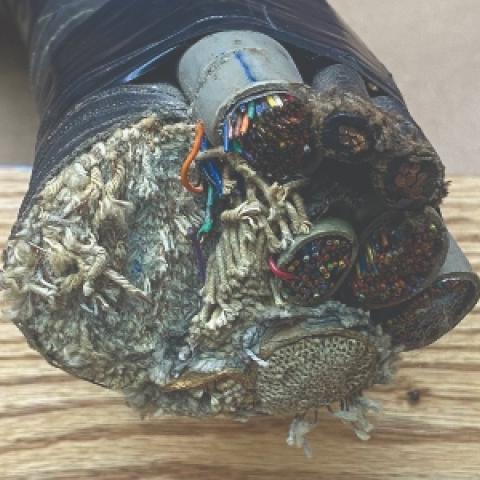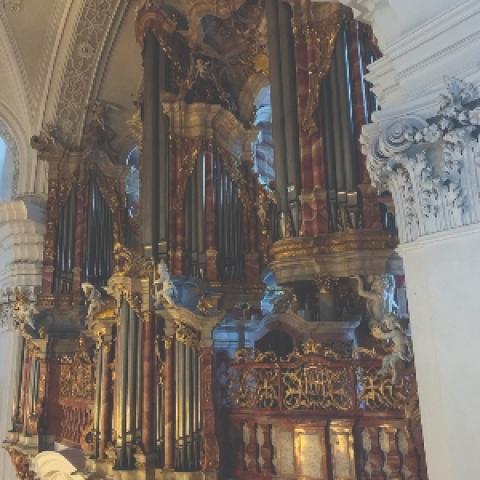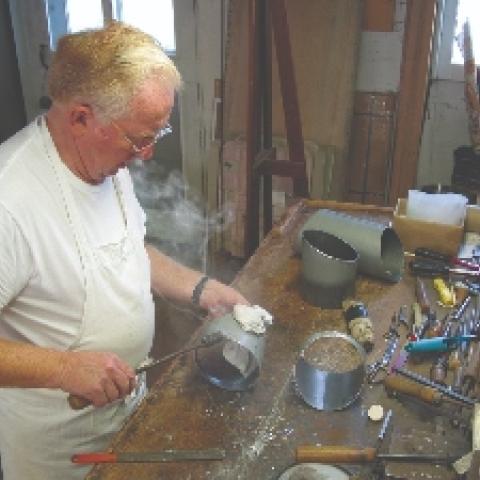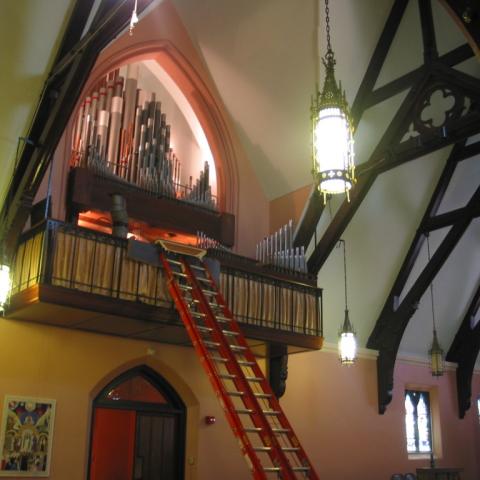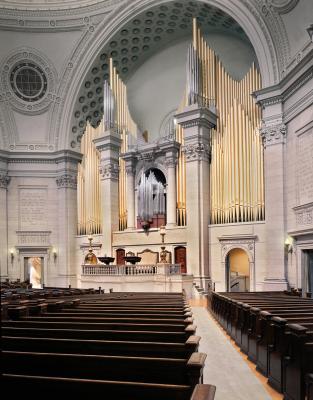
Passing eras
My mother’s grandmother died in Boston in 1959 when I was three years old. I have a dim memory of her and of sitting in the kitchen of her apartment in Boston’s Back Bay at the time of her death, where I was served Cheerios with blue milk, food coloring added by her maid. Granny Reynolds was born in 1867 and remembered her grandmother who was born in 1779. As I grew up, my grandfather made a point of reminding my parents and me of that to keep the milky memory alive. Now, in my early sixties in 2020, I can claim to remember a family member who remembers a family member born during the Revolutionary War. Mozart was twenty-three years old.
Jason McKown (1906–1989) was an old Skinner man. I met him in 1987 when I was engaged to care for the Skinner and Aeolian-Skinner organs at Trinity Church, Copley Square, in Boston (a few blocks from Granny Reynolds’s apartment), where Jason had been organ curator for fifty years. He was eighty-one years old and spry as a cat, easily negotiating the tall ladders and narrow walkboards, but he was eager to retire so he introduced me to another of his clients, The First Church of Christ, Scientist, in Boston, home to the monumental Aeolian-Skinner organ with over two-hundred-forty ranks.
Jason had been caring for that organ since it was installed in 1952, and in order to ensure a smooth transition after I was appointed, the church retained Jason for six months to help me learn the ropes. And some ropes they were. Forty-one ranks of reeds (including a full-length 32′ Kontrafagott and 51⁄3′ Quinte Trompette in the Swell), over a hundred ranks of mixtures (including some harmonic doozies with 7ths and 9ths), and nearly fifty independent ranks in the Pedal. It is a model of engineering, three stories tall and three chambers wide behind an acre of gold-leafed façade pipes. Jason patiently shared his approach to the instrument, its strengths and weaknesses, and the history of repairs and adjustments. We were together at the organ all day every Wednesday for those six months, with Jason leading me around as he offered his hints and insights. After more than sixty years as a tuner, he was an accomplished keyholder.
Shortly before I started at The Mother Church, Ronald Poll of Salt Lake City had been contracted to install a solid-state switching and combination action supplied by Solid State Logic. Ron was the brother of Robert Poll, curator of the huge Aeolian-Skinner organ at the Mormon Tabernacle, and had just completed a similar project there. As Ron started installing the hardware at the various switching stations throughout the organ, I was still maintaining the extensive electro-pneumatic electrical system for its last few months of operation, and I quickly became familiar with one of the weaknesses Jason had mentioned. The machine-formed silver contacts in the vertical gang switches were breaking and falling like pine needles in the forest. There were scores of those switches operating windchest cutouts, single ranks with independent actions, couplers, offset bass chests, and the scores of magical effects found in a huge organ.
When the contacts were manufactured, the bends were formed too crisply, and the wires broke at the bends, with new failures appearing every week. What happened when they fell? They got tangled in the contacts below them and caused cluster-ciphers of five or six notes, terrible interruptions to the marvelous playing of Dr. Thomas Richner, organist of the church, known to generations of students and admirers as Uncle T. “Peepee” (he called everyone Peepee), he’d say, “there’s a little problem in the Pedal Ophicleide.” Some little problem, when a half-dozen notes sounded as one in a stop like that! One afternoon, I was pointing out to Jason how the rows of transistors on the big switching panels compared to the rows of contacts I was so busy repairing. He shook his head and said quietly, “this is for you young guys.”
During those months, as Jason and I shared lunches and coffee breaks, he told stories from his past. He remembered seeing the 32′ Double Open Wood Diapason from the Hutchings organ in Boston’s Symphony Hall, across Massachusetts Avenue from The Mother Church, chain-sawed into pieces and stacked on the sidewalk to make way for the new Aeolian-Skinner organ (Opus 1134, 1947). He remembered talking with Marcel Dupré as the great French organist prepared a recital at King’s Chapel in Boston (Aeolian-Skinner Opus 170-A, 1946), asking how often the Cavaillé-Coll organ at St. Sulpice was tuned. “Not until the next cleaning.” Jason was a direct connection between Marcel Dupré and me.
Jason recommended me to a dozen or so other churches, one of which was especially meaningful. The Congregational Church of West Medford, Massachusetts, was home to Skinner Organ Company’s Opus 692 (1928), a lovely instrument with fourteen ranks. Jason was twenty-two years old when he worked on that installation, under the personal supervision of his employer, Ernest Skinner. The organ was fifty-nine years old when I became the second technician to care for it. Jason was a direct connection between Mr. Skinner and me.
Jason McKown and his wife Ruth were devoted members of Centre Methodist Church in Malden, Massachusetts, where the Bauhaus sanctuary housed a 1973 three-manual Casavant with a harsh angular case design. Jason did not much like that organ, but he maintained it until the end of his life with all the care and skill he gave to his favorite Skinner organs. In those days I drove an eight-passenger van; I ferried a carload of people from The Mother Church to attend his funeral in 1989.
Centre Methodist Church closed in 2007. The Organ Clearing House sold and moved the Casavant organ to Salisbury Presbyterian Church in Midlothian, Virginia. A new case was designed and built by QLF Organ Components, a subsidiary of Lively-Fulcher Organbuilders. Jason was not generous with his comments about the original Casavant case design. I think he would have liked the new one.
Chapters
My friendship with Jason spans eras. I was in my early thirties when I knew him, and over thirty years after his death, I value that he was my personal connection to Ernest Skinner. I admire his longevity, diligence, and devotion to the organs in his care, and I was influenced by his respect especially for Mr. Skinner’s genius. Though he knew it was too late for him to learn about solid-state organ controls, he was open to the new technology being installed in The Mother Church organ. Stories like the destruction of the old Symphony Hall organ told of how he had witnessed deep change in the name of progress.
When Jason first worked at The Mother Church, the fifteen-acre site included the Original Edifice (1894), the first church building built by Mary Baker Eddy, the founder of Christian Science; “The Extension,” the marvelous domed wedding cake of a building (1906) that seats 3,000; and the Publishing Society, home of the renowned international newspaper, The Christian Science Monitor. The site was transformed in 1971 with the construction of the new Christian Science Plaza with three new significant buildings, including a twenty-six-story administration building and a seven-hundred-foot reflecting pool, and the entire plaza was paved with bricks. Jason had been friends with the man whose life work was the creation and care of an extensive rose garden next to the church along Huntington Avenue. When the plaza was built, the rose garden was destroyed. Jason told sweetly of the heartbreak of his friend seeing his life’s work disappear.
Progress
I am a loyal fan of Patrick O’Brian’s marvelous series of novels about the British Navy during the Napoleonic Wars. I have audio recordings of all twenty-one books and often listen to passages in my workshop or as I drive. Captain Jack Aubrey, one of the central characters, is a skillful and courageous frigate captain, and his friend Stephen Maturin is a physician who travels on Jack’s ships as surgeon, which serves as cover for his central activity as a member of Naval Intelligence. Jack plays the violin, well enough to tackle the Bach Chaconne in D Minor, and Stephen plays the cello. As they sail around the world, they play the classics together deep into the night. Jack distinguished between his sea-going fiddle and the precious Amati that he kept at home. One night as they were tuning their strings, Jack’s steward Killick griped to the steward’s mate, “Scrape, scrape, screech, screech, and never a tune you can sing to, not if you were drunk as Davie’s sow.” Those stories are rife with adventure and intrigue. O’Brian was a devoted student of that history, writing dialogue using two-hundred-year-old figures of speech, and for this enthusiastic sailor, he accurately and dramatically describes the act and art of sailing big ships.
As the wars dragged on toward 1815, steam-powered ships were being introduced. It was easy for Jack to understand the advantages of steam power, allowing a ship to sail directly into the wind or without any wind at all. Guns could be mounted facing straight forward and backward, while sailing ships were encumbered by sails and rigging in both those directions and limited to firing broadsides. If your ship had steam power, you had an immense advantage over sail; if you were sailing and encountered an enemy in a steamship, you were in grave peril. Nonetheless, one tradition-bound and slightly drunken admiral lamented loudly about the Navy contemplating losing its skillful sailors to “a hoard of mechanics.”
Steam locomotives powered railroads from the early nineteenth century through the middle of the twentieth. Diesel powered (and diesel-electric) locomotives were first introduced around 1930. By around 1950, diesel locomotives were more powerful, more economical to maintain and operate, and safer than those powered by steam, and steam locomotives became a thing of the past. Many engineers revered the elegance of steam machinery and regretted their demise, but today with few exceptions, steam locomotives are limited to historical exhibits and attractions, and a troupe of hobbyist organbuilders I know.
Friends of ours have a huge old iron cook stove in their kitchen. Susan is a virtuoso with the cooktop lids, lifting them as she converses to drop in a log or two. She manages different levels of heat from one side to another and has pots of savory smelling stuff simmering away. The hulking thing sure does make the kitchen toasty warm on a cold night, but she uses the modern gas cooktop mounted in the counter for most of the cooking. Her curmudgeonly husband Barnaby thinks food tastes better from the wood stove, but he does not cook, ever, and Susan has her way. “Barnaby, have another bourbon.”
Charles-Marie Widor was organist at Saint-Sulpice in Paris for sixty-three years. Something like halfway through his tenure the first electric blower was installed on the Cavaillé-Coll organ. By then he had written the ten organ symphonies that are the backbone of his output, played for thousands of Masses, hundreds of concerts, hundreds of funerals, weddings, and festivals. He must have spent thousands of additional hours at the organ practicing and teaching. Through all of that, the hundred-stop organ was pumped by human power. What a liberation it must have been for him to climb the steps to the organ loft, switch on the power, and play to an empty church using all the wind he wanted.
There are a number of modern mechanical-action organs built under classic inspiration that are pumped by reconstructions of ancient human-powered systems, and in the late 1990s I restored an organ built in 1868 by E. & G. G. Hook (when my great-grandmother was one year old), including restoring the hand pumping system. Yuko Hayashi, the revered long-time professor of organ at the New England Conservatory of Music, brought her organ classes to that church so they could experience hand-powered organ wind, comparing both sources of wind playing the same passage of music. It is a fascinating study, helping us to understand just how music sounded when played centuries ago, but I doubt many of us would forsake the convenience and stability of the electric blower.
The passage of steam-powered ships and locomotives, Susan and Barnaby’s woodstove, and Widor’s hand-pumped organ are all examples of innovations replacing “the old way.” Many pipe organ professionals and enthusiasts are admirers of the old way. “If God intended us to have more than four general pistons, Mr. Skinner would have given us five.” But today’s conversation is not about venerable electro-pneumatic organs being replaced by modern trackers, and it’s not about historic tracker organs being replaced by modern electro-pneumatic instruments. It’s about the future of the organ, the future of all organs.
We can’t save them all.
In the 1920s, American pipe organ builders were producing twenty-five hundred new organs each year. Suburban churches had sixty voice choirs and sixty-stop organs, and a thousand place settings of monogrammed china. Those churches now have dwindling congregations, staggering fuel bills, and leaky roofs. In a world weakened by epidemic, smaller, weaker parishes are struggling like never before, and pipe organs are coming on the market like fireworks on the fourth of July. Hundreds of organs, many of them priceless historic artifacts, are glutting a market in which churches choose between pipe organs, electronic instruments, or no organ-based music at all.
My desk at the Organ Clearing House is proof of that. My inbox is full of pleas to “save this beautiful organ.” We can place only a fraction of the available instruments, and it is hard to justify encouraging a church to purchase an organ of poor quality and doubtful musical interest when so many wonderful organs are available. Once it was hard for me to condemn an organ to the knacker’s yard, but I have gotten over it. I know that there is a finite amount of money spent in the United States each year on pipe organs, and it feels like smart duty to see that as little as possible is spent on lesser organs. If we are going to have fewer organs, they might as well be the best.
An unwanted pipe organ is among the greatest of white elephants. This applies to instruments of high pedigree and important historical value as much as to small, simple, ordinary instruments. When progress means that a building has to go, whatever is inside goes with it. If it is a historical home with a beautiful organ, when time’s up, time’s up. If it is a spectacular church building, ravaged by time and weather and failing budgets, whatever is inside goes with it.
If you learn that a church in your neighborhood is planning to close, encourage them to think right away of the artifacts that should be saved. Pipe organs, stained-glass windows, and liturgical furnishings can all be preserved and relocated, but it takes time. If my first contact about an available organ is from the real-estate developer who bought the building and plans to gut the interior in two weeks, there is no hope. As it takes years for a church to decide to commission a new organ, it takes years for a congregation to embrace the idea of disbanding. Plan ahead.
Most importantly, we must care for our profession. Colleague organbuilders and organists must project their work in the music of the church as a rich gift. We have received our talents as gifts. It is our responsibility to nurture those talents and share them with the people in our churches, those in the pews, and those around the table at weekly staff meetings. Make them love what you do. I am tired of seeing memes showing the Dowager Countess of Grantham with pursed lips, saying that people who think the organ is too loud “don’t have any taste.” I am tired of seeing images of gag stop knobs engraved with “Rector Ejector,” or “Cut Pulpit Mic.” They may be good for a smirk between organists, but they imply an underlying disrespect that is not good for our future.
An organist accepting a new position “if there will be a new organ” is an affront to church music. Maybe the place should have a new organ, but that should be the collective decision of a generous and worshipful community with the support and encouragement of the musicians, not an arrogant demand. You likely know more about church music than those around you, but with your help, they can love it as much as you do. That is what honors the links between you and the centuries-old procession of brilliance which is the heritage of our music and our instruments. That’s our future.
Photo: 1952 Aeolian-Skinner Opus 1203, The Mother Church Extension, The First Church of Christ, Scientist, Boston, Massachusetts (photo credit: William T. Van Pelt)


